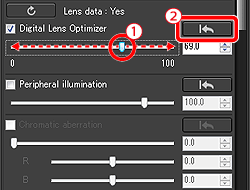The Digital Lens Optimizer tool is a feature in Digital Photo Professional used during post-processing to clean aberrations in colors, tone, and resolution resulting from diffraction phenomena. The design of the lens and the shape of the glass is used to automatically improve the image.
System and software requirements
To use this function, [Lens data] for the lens used to shoot images first needs to be downloaded to your computer.
- You need a reliable internet connection to download lens data. Data downloads may take a few minutes depending on your connection speed.
- Administrator permissions on the local computer are required.
- Digital Lens Optimizer only works with RAW images. JPEG, TIFF, S-RAW, and M-RAW images cannot be corrected.
Compatibility check
- At your computer, Start Digital Photo Professional version 4.x, then display the RAW image you would like to edit.
- Display the tool palette, and then switch to the [
 ] tab. Alternatively, select the Tool palate from the Display menu on the tool bar.
] tab. Alternatively, select the Tool palate from the Display menu on the tool bar.
- Check the status of [Lens data] for [Digital Lens Optimizer].
- Lens data: Not Available - This means the image was taken with a camera or lens that is not compatible with Digital Lens Optimizer or that the image is not in the RAW format.
- Lens data: No - You can use Digital Lens Optimizer but need to download lens data first
- Lens data: Yes - Lens data is downloaded and the image is compatible.
Download lens data
Skip this section if you already have lens data.
- Click [
 ].
].
- The Add or Remove lens data window appears.
- Check the box next to the lens used to shoot the image and then click Start.
- You can download data for up to 30 lenses at one time.
- Data for one lens can be 25 MB.
- Delete lens data by unchecking the box in the Add or Remove lens data window.
- Click Close after the download finishes.
- Check that Lens data: Yes is shown in Digital Lens Optimizer.
Apply corrections
When applying the Digital Lens Optimizer, the effect of [Sharpness] or [Unsharp mask] may become excessive. It is recommended that you set [Sharpness] or [Strength] for [Unsharp mask] for images to 0 before using the Digital Lens Optimizer. Adjust [Sharpness] or [Unsharp mask] again after applying the Digital Lens Optimizer to images.
- Use the tool palette to perform adjustments.

- Use the slider
 to adjust the Digital Lens Optimizer effect.
to adjust the Digital Lens Optimizer effect.
- Click
 [
[  ] to revert to the original image.
] to revert to the original image.
- Adjust sharpness or unsharp mask if requred.
Good to know